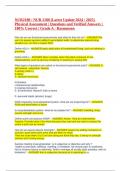NUR2180 / NUR 2180 (Latest Update )
Physical Assessment | Questions and Verified Answers |
100% Correct | Grade A - Rasmussen
Why do we use functional assessments and what do they tell us? - ANSWER We
use it to assess persons ability to accomplish skills, to determine optimal living
situation (ex: no ADL's maybe SNF)
Define ADL's - ANSWER basic daily tasks of fundamental living, such as toileting or
grooming
Define IADL's - ANSWER More complex tasks that allow someone to live
independently, such as grocery shopping or cleaning or paying bills
What types of questions are asked on functional assessment tools? - ANSWER S-
self esteem : education, finance
A-activity (ADL's )
S-Sleep
S- Spiritual resources:
N-Nutrition
I-Interpersonal relationships
C-Coping (stressors)
E- Environment/ Hazard? Safe at home
P- personal habits (alcohol, drugs)
While inspecting musculoskeletal system, what are we inspecting for? - ANSWER
ROM and deformities of spine
In musculoskeletal system- what do we palpate for? - ANSWER Swelling, temp,
muscle strength and score
Define active and passive ROM? - ANSWER Active: They do it themselves
Passive: Provider does it for them because they cant and we want to assess the
extent a joint can be moved
How do we assess Muscle Strength? - ANSWER assess by adding resistance to
muscles :push down their arms and ask them to resist
Then we score them 0 to 5 on how strong we think they are. 0 being no strength
(stroke) and 5 being strong.
Sample charting musculoskeletal : is it subjective or objective and why ?
"states no joint pain, stiffness, swelling, or limitation. No muscle pain or weakness.
No hx of bone trauma or deformity. Able to manage all usually daily activities, with no
limitations" - ANSWER this is subjective because pt is reporting to us
, Sample charting: Musculoskeletal is it subjective or objective and why?
"Joints and muscles symmetric, no swelling, masses, deformities, normal spinal
curvature. No tenderness to palpations of joints, no heat or swelling, or masses. Full
ROM, movement smooth no crepitus, or tenderness to muscle. Muscle strength: able
to maintain felxion against resistance and w/o tenderness 5/5" - ANSWER Objective:
what we collected
Tenderness on palpation is considered objective or subjective and why? - ANSWER
usually subjective, but if pt has tenderness upon palpation its objective because it
was found on physical examination
Define abduction in lower and upper extremities - ANSWER LE: Swing leg out
directly to side (stretch before squat) and turning foot inward
UE: Swings arms out (flapping wings)
Define adduction on lower and upper extremities - ANSWER LE: Turn foot out and
swing leg in
UE: swinging arms inward
Define Flexion on upper and lower extremities - ANSWER Upper: bring hand to
chest
Lower: bend knee and bring leg upwards
Define extension for upper and lower extremities - ANSWER Upper: extend hand out
and bring hand to thigh
Lower: bring entire straight leg up
Define ROM in neck - ANSWER 3 moves
Skull to shoulder /skull to shoulder
Chin to chest/chin to ceiling
Look to left and look to right
Define Lordosis - ANSWER spinal deformity where LOW back bends in and belly
shoots out
Define Kyphosis - ANSWER spinal deformity where you look like the Hunchback of
Notre Dame. Belly bends in and top part of back protrudes
Define scoliosis - ANSWER Spinal deformity where spine actually curves
Upon inspection of skin, what are we looking for? Give names of colors as well -
ANSWER Hair distribution
general pigmentation
Color (pallor- pale) (blue/cyanosis -lacking O2) (yellow- jaundice) (erythema-red)
Moles (nevi)
Lesions (color, elevation, pattern, size, location)
What are we palpating for on skin? - ANSWER Temp
Texture: rough or smooth




